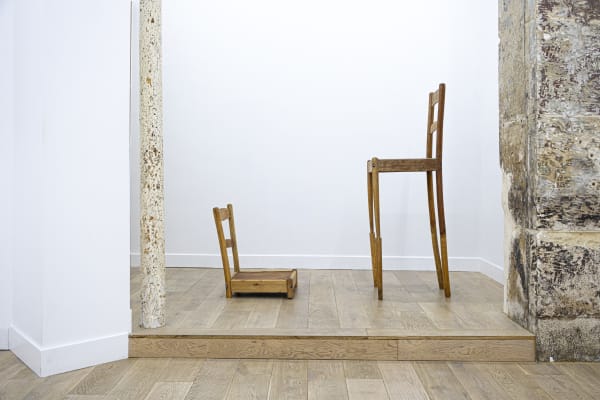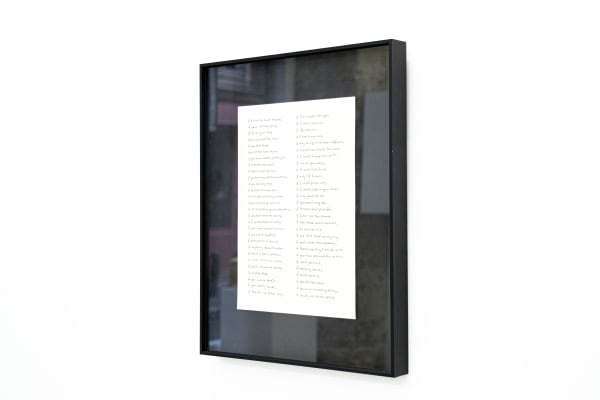Echoes of Repetitions: Paris, France
The Bridge Gallery is delighted to present Echoes of Repetitions, an exhibition bringing together for the first time the painter JC Bright (Nigeria, 1994), the multidisciplinary artist Dale Lawrence (South Africa, 1988), and the artist, writer, and curator Khanyi Mawhayi (South Africa, 1998). With this new exhibition, The Bridge Gallery offers a reflection on the contemporary African art scene through the prism of repetition within the creative process.
Far from being a mere formal device, repetition becomes a language for these three artists. It unfolds in the circular gestures and taut threads of Khanyi Mawhayi, where each movement opens a space for listening and empathy; in the chromatic strokes of JC Bright, which celebrate maternal heritage and family narratives; and in the rearranged texts and objects of Dale Lawrence, where words are emptied of meaning to reveal their music, and where each permutation invents a fragile, ever-temporary balance.
With Empathy for a Mosquito and Waterfalls of the Sun (After Mary Oliver), Khanyi Mawhayi continues her series Black and White Paradise, a body of work exploring the complexities of human relationships and the shadow zones of empathy. She questions our capacity to welcome what unsettles us—parasites, contradictions, fragments of ourselves—and transforms that act of listening into artistic material. Her visual language combines stretched lines of wool across the canvas with vibrant bands of color drawn in oil stick, creating a subtle dialogue between textile and pictorial material. As the artist herself notes: “The territories of abstraction allow for more play, more opacity… more possibilities.”
Dale Lawrence explores language, time, and materiality. In his textual works, he extracts phrases from transient sources and reorders them into poetic journals, printed in programming typefaces. Gathered into compact blocks of epoxy resin or adhesive tape, these fragments disperse in meaning. The phrases drift, emptied of their original function, becoming almost ornamental. His use of anaphora heightens the rhythm, turning repetition into a musical gesture that reveals the hidden patterns of language and time.
In Composition in Black and White (2018/21), Lawrence rearranges randomly collected books, whose juxtaposed titles form provisional, ever-shifting narratives. This repetitive act—selecting, arranging, reconfiguring—questions both the construction of meaning and the tension between novelty and recurrence.
In Nameless and Friendless, two chairs face each other, awaiting an impossible dialogue. The legs of one, severed, elevate the other, yet both remain in untenable positions. The hierarchy is visible but sterile: the elevation of one occurs at the expense of both. Echoing Emily Mary Osborn’s 1857 painting of the same name, the work exposes the repetition of power relations, both colonial and contemporary. In Lawrence’s practice, this physical imbalance becomes a metaphor for the recurring structures of domination through time.
-
 JC BrightNo Better Love, Painting No. 1, 2024Acrylic and Oil on canvas45 x 60 cm
JC BrightNo Better Love, Painting No. 1, 2024Acrylic and Oil on canvas45 x 60 cm -
 JC BrightNo Better Love, Painting No. 4, 2024Acrylic and Oil on canvas60 x 45 cm
JC BrightNo Better Love, Painting No. 4, 2024Acrylic and Oil on canvas60 x 45 cm -
 Khanyi MawhayiWaterfalls of the Sun (After Mary Oliver), 2025Oil pastel and yarn on canvas133 x 131 cm
Khanyi MawhayiWaterfalls of the Sun (After Mary Oliver), 2025Oil pastel and yarn on canvas133 x 131 cm -
 Khanyi MawhayiEmpathy for a mosquito, 2025Oil pastel and yarn on canvas110 x 90 cm
Khanyi MawhayiEmpathy for a mosquito, 2025Oil pastel and yarn on canvas110 x 90 cm -
 Dale LawrenceNameless and Friendless, 2019Chairs
Dale LawrenceNameless and Friendless, 2019Chairs -
 Dale LawrenceIf It’s All the Same to You, 2018Ink on paper31 x 20 cm
Dale LawrenceIf It’s All the Same to You, 2018Ink on paper31 x 20 cm -
 Dale LawrenceComposition in Black and White, 2018 / 21
Dale LawrenceComposition in Black and White, 2018 / 21


























